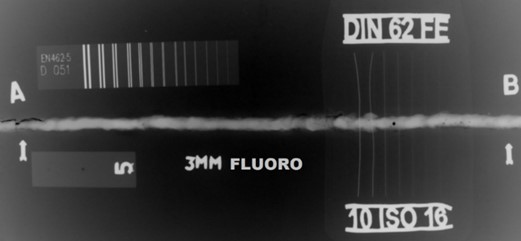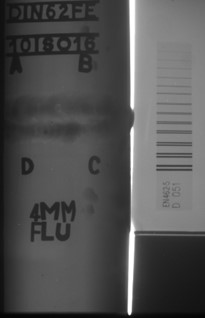

Industrial Fluoroscope System (IFS) is an indigenously developed, low cost, modern digital radiography system (Figure 1) for industrial applications. The system is useful for digital radiography of variety of components & sub-assemblies. This can be used for radiographic inspection of in-process jobs as well as finished components.
Film based Radiography testing, which uses penetrating radiation either Gamma or X-Rays, is quite popular and widely accepted as a non-destructive testing (NDT) tool by manufacturing industries because of its capability to reveal the internal detail of a 3 D component as a projected 2 D image, known as a radiograph.
Film radiography suffers from disadvantage of having a considerable time lag between exposure and image viewing as films need to be chemically processed to develop the latent image formed during exposure. In fluoroscopy the projected image formed on a fluorescent screen, instead of a film, is viewed immediately while X-Ray exposure is on. This feature makes the system more suitable for monitoring any dynamic change in live mode. Though suitable for real time visualisation, this basic version of fluoroscope lacks recording feature for the purpose of reporting and offline interpretation. Advent of Computer and Electronic devices has now made possible to couple fluoroscope with camera and computer to obtain digital output of the image (Figure 2), which can be further subjected to processing software for quality enhancement, records, sizing, archiving, offline viewing.
In comparison to conventional film system, digital radiography offers a series of benefits in terms of productivity, sensitivity, low X-Ray dose, environmental aspects, automated acquisition, image processing, image storage image retrieval and cost reduction.
The present IFS combines the benefit of both the real time radiography and the digital radiography.
Unlike fluoroscope other systems such as Digital Detector Array (DDA) and Computed Radiography (CR) with different image acquiring technology are also available but they are rather costlier and therefore not affordable to small scale manufacturers.
In order to have this cost effective IFS in the Indian market, the complete manufacturing technology along with testing and validation methods for imaging device (excluding X-ray Source) is made available at BARC.
Industrial sectors belonging to manufacturing, nuclear, aerospace, defence, security, automobile and petrochemicals are potential users of IFS for their quality control applications.
General
| Sr. No. | Specification | Value |
|---|---|---|
| 1 | Overall Size | 375 x 250 x 185mm |
| 2 | Weight | 40kg Approx. |
| 3 | Material | SS & Lead |
| 4 | Lead Glass Size | 79 x 68 x 15mm Thk. |
Fluorescent Screen
| Sr. No. | Specification | Value |
|---|---|---|
| 1 | Fluorescent Screen Size | 230 x 230mm |
Camera & Lens
| Sr. No. | Specification | Value |
|---|---|---|
| 1 | Resolution | 2.3MP | 2 | Sensor Type | CMOS |
Mirror
| Sr. No. | Specification | Value |
|---|---|---|
| 1 | Material | Glass | 2 | Mirror Size | 180 x 130 x 6mm Thk. |
Manual Adjustments
| Sr. No. | Specification | Value |
|---|---|---|
| 1 | Z-Motion to Camera | ±12 mm | 2 | Mirror Position | 45° |
| 3 | Angular Adjustment | ±5° |
The results produced using IFS conforms to ISO 17636 Part-2 Class A.
Earlier fluoroscopy was used in medical field for taking X-rays of human body parts. Those fluoroscopes consisted of an X-ray source and a fluorescent screen, between which the patient was placed. After passing through the patient, the X-ray beam impinged upon the fluorescent screen and produced a visible glow, which was directly observed by the practitioner. Unlike film based radiography, fluoroscopy is capable of producing real time image; hence it is a preferred option for investigating parts where dynamic changes are required to be observed.
In modern systems, the fluorescent screen is coupled to an electronic device that transforms the glow into a digital image signal suitable for presentation on an electronic display. The benefit of modern system compared to the earlier approach is that the operator need not stand in close proximity to the fluorescent screen in order to observe the image. This results in a substantial reduction in radiation dose to the operator. Digital radiography is rapidly taking over film radiography in quality control practices in the industry.
Industrial Fluoroscope System (IFS) is an indigenously developed, low cost means for Industrial Digital Radiography.
The system gives real time imaging at very low cost. The radiographic image is generated in digital format. The complete system consists of Fluoroscope Assembly, Connecting Cables, Camera and Laptop with image storage and retrieval system and interactive support software.
Constant Potential X-ray machine up to 225kV capacity and with 0.4mm focal spot shall be used to create digital radiographic image of required quality. This system can be used to take digital radiographic image of any component of thickness varying from 3mm to 20mm of Steel equivalent.
Unlike Computed Radiography (CR) and Digital Detector Array (DDA), fluorescent screens do not require image erasing/removal between two consecutive exposures because of very low decay time. Further they have very low probability of occurrences of ghost images. These result in clean image as well as longer life of fluorescent screen.
Fabrication
| Activity | No. of Persons Required |
|---|---|
| Mechanical Engineer | 01 | Electronics Engineer | 01 |
| Fitter | 01 |
| Inspector | 01 |
| Machinist | 01 |
Operation
| Activity | No. of Persons Required |
|---|---|
| Radiographer (RT Level-1) | 01 | Radiography Inspector (RT Level-2) | 01 |



